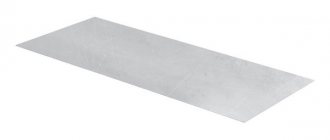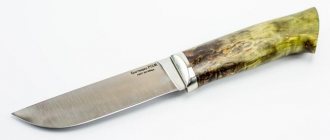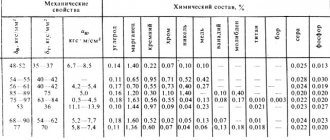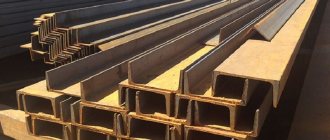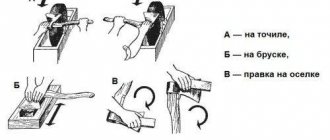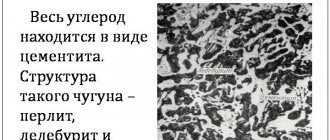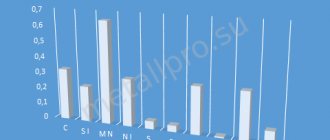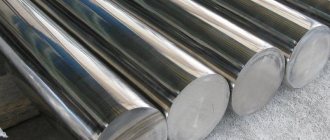General information
The quality of steel used in the manufacture of metal
structures is determined by its mechanical properties: resistance to static influences, dynamic influences and brittle fracture at various temperatures; plasticity indicators - relative elongation; resistance to delamination - bending in a cold state. The values of these indicators are established by GOST. In addition, the quality of steel is determined by its weldability, which is guaranteed by the appropriate chemical composition of the steel and its production technology.
Based on their strength, steel is divided into three groups:
- low carbon steels (ordinary quality)
- high strength steel
- high strength steel
The mechanical properties of steel and its weldability depend on the chemical composition, heat treatment and rolling technology.
The basis of steel is ferrite. Ferrite has low strength and is very plastic, therefore in its pure form it is not used in building structures. Its strength is increased by carbon additives - low-carbon steels of normal strength; alloying with manganese, silicon, vanadium, chromium and other elements - low-alloy steels of increased strength; alloying and thermal hardening of high strength steel.
Hardness of steels
When testing for hardness, the mechanical properties of steels are assessed by introducing a solid material, the so-called indenter, into it at a given force (Figure 3). Often such an indenter is made of diamond. As a result of the test, an imprint is formed in the material - its size is judged by the hardness of the steel: in the Rockwell test - by the depth of the imprint, in the Brinnell and Vickers tests - by its width.
Figure 3 – Hardness test scheme and its main characteristics
Harmful impurities
These primarily include: phosphorus,
which, forming a solution with ferrite, increases the brittleness of steel, especially at low temperatures (cold brittleness) and reduces ductility at elevated temperatures;
sulfur,
which makes steel red-brittle (prone to cracking at temperatures of 800–1000 C) due to the formation of fusible iron sulfide. Therefore, the content of sulfur and phosphorus in steel is limited; So in carbon steel St 3, sulfur is up to 0.05% and phosphorus is up to 0.04%.
The mechanical properties of steel are adversely affected by saturation with gases that can enter the metal in a molten state from the atmosphere. Oxygen acts like sulfur, but to a greater extent and increases the brittleness of steel. Unfixed nitrogen also reduces the quality of steel. Hydrogen, although retained in an insignificant amount (0.0007%), but concentrating near inclusions in intercrystalline regions and located mainly along the boundaries of blocks, causes high stresses in microvolumes, which leads to a decrease in the resistance of steel, brittle fracture, a decrease in tensile strength and plastic properties become. Therefore, molten steel (for example during welding) must be protected from exposure to the atmosphere.
Heat treatment
In addition to alloying, a significant increase in the strength, deformation and other properties of steel is achieved by heat treatment due to the fact that under the influence of temperature, as well as heating and cooling modes, the structure, grain size and solubility of the alloying elements of steel change.
The simplest type of heat treatment is normalization. It consists of reheating the rolled product to the temperature of austenite formation and subsequent cooling in air. After normalization, the steel structure becomes more ordered, internal stresses are relieved, which leads to an improvement in the strength and plastic properties of rolled steel and its impact toughness. Therefore, normalization, being the simplest type of thermal improvement of steel, is used quite often.
With the rapid cooling of steel heated to a temperature exceeding the phase transformation temperature, hardening is obtained. For hardening, it is necessary that the cooling rate be higher than the phase transformation rate.
The structures formed after hardening give the steel high strength. However, its ductility decreases, and its tendency to brittle fracture increases. To regulate the mechanical properties of hardened steel and the formation of the desired structure, it is tempered, i.e., heated to a temperature at which the desired structural transformation occurs, held at this temperature for the required time and then slowly cooled.
Aging is promoted by:
- mechanical effects and especially the development of plastic deformations (mechanical aging);
- temperature fluctuations leading to changes in the solubility and rate of diffusion of components and therefore to their release (physico-chemical aging, dispersion hardening). Low heating (up to 150 – 200 C) can dramatically enhance the aging process.
With plastic deformation and subsequent slight heating, the intensity of aging increases sharply (artificial aging). Since aging reduces resistance to dynamic impacts and brittle fracture, it is considered a negative phenomenon. Steels that are contaminated and saturated with gases, such as boiling steel, are most susceptible to aging.
Undeoxidized steels boil when poured into molds due to the release of gases; such steel is called boiling steel
and turns out to be more clogged with gases and less homogeneous.
Boiling steels, having fairly good yield strength and tensile strength, have poor resistance to brittle fracture and aging.
To improve the quality of low-carbon steel, it is deoxidized by adding silicon from 0.12 to 0.3% or aluminum up to 0.1%; silicon (or aluminum), combining with dissolved oxygen, reduces its harmful effects. When combined with oxygen, deoxidizers form silicates and aluminates in a finely dispersed phase, which increase the number of crystallization sites and contribute to the formation of a fine-grained steel structure, which leads to an increase in its quality and mechanical properties. Deoxidized steels do not boil when poured into molds, which is why they are called calm steels.
Calm steel is more homogeneous, welds better, and better resists dynamic influences and brittle fracture. Mild steels are used in the manufacture of critical structures exposed to static and dynamic influences.
Semi-calm
The quality of steel is intermediate between boiling and calm. It is deoxidized by a smaller amount of silicon - in the amount of 0.05 - 0.15% (rarely by aluminum).
Alloying additives in alloys
These are substances deliberately added to the melt to improve the properties of the alloy and bring its parameters to the required ones. Some of them are added in large quantities (more than a percent), others in very small quantities. I most often use the following alloying additives:
- Chromium. Used to increase hardenability and hardness. Share – 0.8-0.2%.
- Bor. Improves cold brittleness and radiation resistance. Share – 0.003%.
- Titanium. Added to improve the structure of Cr-Mn alloys. Share – 0.1%.
- Molybdenum. Increases strength characteristics and corrosion resistance, reduces fragility. Share – 0.15-0.45%.
- Vanadium. Improves strength parameters and elasticity. Share – 0.1-0.3%.
- Nickel. Promotes an increase in strength characteristics and hardenability, but at the same time leads to an increase in fragility. This effect is compensated by the simultaneous addition of molybdenum.
Read also: Lost wax casting in brief
Metallurgists also use more complex combinations of alloying additives, achieving unique combinations of physical and mechanical properties of steel. The cost of such grades is several times (or even tens of times) higher than the cost of conventional low-carbon steels. They are used for particularly critical structures and assemblies.
If you find an error, please select a piece of text and press Ctrl+Enter.
Modern production requires a large number of durable steel products. Various steels are used in the construction of bridges, houses, and complex structures. One of the most important issues is the calculation of the strength of the metal and the stress value of the steel reinforcement. In order for structures to serve for a long time and be safe, it is necessary to accurately know the yield strength of the steel material that is subject to the main load.
Low-carbon steels of ordinary quality
From the group of low-carbon steels of ordinary quality produced by the metallurgical industry in accordance with GOST 380 - 88, steel grade St3 is widely used in construction.
Steel grade St3 is produced boiling (ST3kp), semi-quiet (St3ps) and calm (St3sp).
Depending on the purpose, steel is supplied in the following three groups, which indicate the properties by which steel is standardized:
A - by mechanical properties;
B - by chemical composition;
B - according to mechanical properties and chemical composition
Since it is necessary to ensure strength and weldability for load-bearing building structures, as well as adequate resistance to brittle fracture and dynamic impacts, steel for these structures is ordered according to group B, i.e., with a guarantee of mechanical properties and chemical composition.
Steel grade St3 contains 0.14 – 0.22% carbon.
According to GOST 380 - 88, steel marking is done as follows: first put the corresponding letter designation of the steel group, then the grade, then the deoxidation method and finally the category; for example, steel of group B (supplied according to mechanical properties and chemical composition) grade St3 is semi-quiet, category 5 is designated VSt3ps5.
The category indicates which mechanical properties of steel are preserved at temperatures of -20 and +20 degrees Celsius. Ordinary quality steels are divided into 5 categories. The table of standardized indicators by category is given in GOST 535-88.
Using the properties of metals
Two important indicators - plasticity and PP - are interrelated. Materials with a large first parameter degrade much more slowly. They change their shape well and are subjected to various types of metal processing, including die stamping - that’s why car body elements are made from sheets. With low ductility, alloys are called brittle. They can be very hard, but at the same time have poor stretching, bending and deformation, for example, titanium.
Resistance
There are two types:
- Regulatory - prescribed for each type of steel in GOSTs.
- Calculated - obtained after calculations in a specific project.
The first option is rather theoretical; the second is used for practical tasks.
Increased and high strength steels
For many types of structures, high-strength and high-strength steels are used.
Increased and high strength steels are supplied in accordance with GOST 19281 - 89 and GOST 19282 - 89. Depending on the standardized properties (chemical composition, tensile strength, yield strength, impact strength at different temperatures and after mechanical aging), according to GOST these steels are divided into 15 categories with a guarantee of mechanical properties at temperatures from -70 to +20 degrees Celsius.
The use of high-strength steel leads to metal savings of up to 20–25%, and high-strength steel – 25–50% compared to conventional carbon steel.
GOST 27772-88
Since 1988, GOST for rolled steel for building steel structures was introduced. In this GOST, steel grades of ordinary quality, increased and high strength are given new names, for example S245, S390, S590K. The letter C means construction steel, the numbers conventionally indicate the yield strength of rolled products (the physical properties of steel), the letter K is a variant of the chemical composition. According to this GOST, steels are divided into 4 categories with a guarantee of mechanical properties at temperatures of -40, -70 degrees and after mechanical aging.
This GOST does not replace those mentioned above, but exists in parallel. So, according to different GOST standards, the same grade of steel can be designated by two names, for example, C235 and VSt3kp2 are the same steel. The conversion table for steel names is given in Appendix No. 1 to GOST 27772-88.
If you have any questions, call 281-57-57. Email
